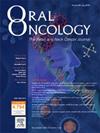A review of histopathologic assessment for head and neck oncologists
IF 4
2区 医学
Q1 DENTISTRY, ORAL SURGERY & MEDICINE
引用次数: 0
Abstract
Goal of Review
With a deeper understanding of histopathologic assessment, head and neck oncology specialists (surgical oncologists, radiation oncologists, and medical oncologists) will be better equipped to address the increasing complexity encompassing head and neck cancer management.
Introduction
Histopathologic assessment of surgical specimens imparts crucial information that is essential for post-operative treatment planning and prognostication for patients with head and neck squamous cell carcinoma (HNSCC). Herein, we discuss the most current guidelines and recommendations to elucidate the clinically relevant histopathologic features in HNSCC. This review discusses the following pathology features: extranodal extension, margins, perineural invasion, histologic grade, dysplasia, depth of invasion, lymphovascular invasion, and other considerations such as p16 immunohistochemistry, HPV in situ hybridization and worst pattern of invasion.
Discussion
Understanding histopathology in HNSCC is essential for accurate diagnosis, prognostication, understanding tumor behavior, and treatment management. This complexity of care has led to consensus guidelines from numerous authorities which this paper discusses and summarizes for readers.
Conclusion
The understanding of key histopathology elements in HNSCC will augment multidisciplinary discussions and improve patient care. The current variability in existing consensus guidelines highlights the need for improved standardization of histopathology reporting in HNSCC. Standardization will enhance diagnostic accuracy, guide clinical decision-making, and facilitate the development of more effective treatment strategies.
头颈部肿瘤学家组织病理学评估综述
随着对组织病理学评估的深入了解,头颈部肿瘤专家(外科肿瘤学家、放射肿瘤学家和内科肿瘤学家)将更好地应对日益复杂的头颈部肿瘤管理。手术标本的组织病理学评估为头颈部鳞状细胞癌(HNSCC)患者的术后治疗计划和预后提供了重要信息。在此,我们讨论最新的指南和建议,以阐明HNSCC的临床相关组织病理学特征。本文讨论以下病理特征:结外延伸,边缘,神经周围浸润,组织学分级,发育不良,浸润深度,淋巴血管浸润,以及其他因素,如p16免疫组织化学,HPV原位杂交和最严重的浸润模式。了解HNSCC的组织病理学对于准确诊断、预测、了解肿瘤行为和治疗管理至关重要。这种护理的复杂性已经导致了共识的指导方针,从众多的权威,本文讨论和总结为读者。结论了解HNSCC的关键组织病理学因素将增加多学科讨论并改善患者护理。现有共识指南目前的可变性突出了HNSCC组织病理学报告标准化的需要。标准化将提高诊断的准确性,指导临床决策,并促进制定更有效的治疗策略。
本文章由计算机程序翻译,如有差异,请以英文原文为准。
求助全文
约1分钟内获得全文
求助全文
来源期刊

Oral oncology
医学-牙科与口腔外科
CiteScore
8.70
自引率
10.40%
发文量
505
审稿时长
20 days
期刊介绍:
Oral Oncology is an international interdisciplinary journal which publishes high quality original research, clinical trials and review articles, editorials, and commentaries relating to the etiopathogenesis, epidemiology, prevention, clinical features, diagnosis, treatment and management of patients with neoplasms in the head and neck.
Oral Oncology is of interest to head and neck surgeons, radiation and medical oncologists, maxillo-facial surgeons, oto-rhino-laryngologists, plastic surgeons, pathologists, scientists, oral medical specialists, special care dentists, dental care professionals, general dental practitioners, public health physicians, palliative care physicians, nurses, radiologists, radiographers, dieticians, occupational therapists, speech and language therapists, nutritionists, clinical and health psychologists and counselors, professionals in end of life care, as well as others interested in these fields.
 求助内容:
求助内容: 应助结果提醒方式:
应助结果提醒方式:


